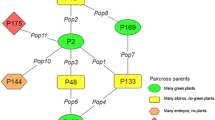Summary
Estimates of gene actions were obtained for five in vitro traits of immature wheat (Triticum aestivum L.) embryo cultures from a cross of two wheat cultivars and the resulting reciprocal, F1, F2 and backcross populations. The contribution of additive gene effects to in vitro traits was not as important as the dominance gene effects. Epistatic gene effects were relatively more important than either additive or dominance gene effects. Of the individual types of digenic epistatic effects, the dominance x dominance estimates were relatively larger in magnitude for all in vitro culture traits measured. The maternal effect played a minor role in the inheritance of the in vitro studied traits since the difference among the reciprocal values was not significant. It is shown from the generation mean method that epistasis played a major role in the inheritance of most of the traits under study. The negative values of additive and dominance genetic variance were estimates of zero. Heritability estimates, in broad sense, were relatively high for the in vitro studied traits. In some cases, heritability estimates in broad and narrow senses are almost equal since the estimation of dominance genetic variance led to negative values. According to the results of the gene effects, dominance and epistasis were important for the shoot formation trait. Selection would be effective among the isolated genotypes on individual basis.
Similar content being viewed by others
References
Barakat, M.N., 1994. Combining abilities of in vitro traits in wheat (Triticum aestivum L) immature embryo culture. Euphytica 76: 169–175.
Barakat, M.N. & T.H. Abdel-Latif, 1994. Somatic embryogenesis and plant regeneration in callus from mature and immature embryo cultures of wheat. Abstracts VIIIth International congress of Plant Tissue and Cell Culture. Firenze, Italy, June 12–17. p. 14.
Chaleff, R.S., 1981. Genetics of higher plants; applications of cell culture. Cambridge University Press, Cambridge, U.K.
Chu, Q.R. & T.P.Croughan, 1990. Genetics of plant regeneration in immature panicle culture of rice. Crop sci 30: 1194–1197.
Cooper, D.B., R.G.Sears, G.L.Lookhart & B.L.Jones, 1986. Heritable somaclonal variation in gliadin proteins of wheat plants derived from immature embryo callus culture. Theor AppI Genet 71: 784–790.
Davies, P.A., M.A.Pallotta, S.A.Ryan, W.R.Scowcrft & P.J.Larkin, 1986. Somaclonal variation in wheat: genetic and cytogenetic characterisation of alcohol dehydrogenase I mutants. Theor AppI Genet 72: 644–653.
Deaton, W.R., S.G.Metz, T.A.Armstrong & P.N.Mascia, 1987. Genetic analysis of the anther-culture response of three spring wheat crosses. Theor Appl Genet 74: 334–338.
Gamble, E.E., 1962. Gene effects in corn (Zea mays L.): II. Relative importance of gene effects for plant height and certain component attributes of yield. Can. J. Plant Sci. 42: 349–358.
Maddock, S.E., V.A.Lancaster, R.Risiott & J.Fronklin, 1983. Plant regeneration from cultured immature embryos and inflourescences of 25 cultivars of wheat (Triticum aestivum L.). J. Exp. Bot. 34: 915–926.
Mather, K. & J.L.Jinks, 1971. Biometrical genetics. The study of continuous variation. Cornell University Press, Ithaca, New York.
Miah, M.A.A., E.D.Earle & G.S.Khush, 1985. Inheritance of callus formation ability in anther culture of rice (Oryza sativa L.). Theor. Appl. Genet 70: 113–116.
Murashige, T. & F.Skoog, 1962 A revised medium for rapid growth and bioassays with tobacco tissue cultures. Physiol. Plant. 15: 473–497.
Peng, J.Y. & T.K.Hodges, 1989. Genetic analysis of plant regeneration in rice (Oryza sativa L.). In Vitro Cell Dev. Biol. 25: 91–94.
Ryan, S.A., P.J.Larkin & F.W.Ellison, 1987. Somaclonal variation in some agronomic and quality characters in wheat. Theor. Appl. Genet. 74: 77–82.
Tomes, D.T. & E.B. Swanson, 1982. Application of in vitro selection to plant improvement. In: Tomes DT, Ellis BI, Harney PM, Kasha K, Peterson RL (Eds). Application of plant cell and tissue culture to agriculture and industry, University of Guelph, pp. 25–43.
Warner, J.N., 1952. A method for estimating heritability. Agron. J. 44: 427–430.
Zhang, Z.H. & Q.R.Chu, 1985. Biometrical analysis on anther culturability in rice (Oryza sativa L.). Acta Agric. Shanghai 1 (3): 1–10
Zhang, C. & C.Qifeng, 1993. Genetic studies of rice (Oryza sativa L.). anther response. Plant Cell, Tissue and Organ Culture 34: 177–182.
Author information
Authors and Affiliations
Rights and permissions
About this article
Cite this article
Barakat, M.N. Estimation of genetic parameters for in vitro traits in wheat immature embryo cultures involving high X low regeneration capacity genotypes. Euphytica 87, 119–125 (1996). https://doi.org/10.1007/BF00021884
Received:
Accepted:
Issue Date:
DOI: https://doi.org/10.1007/BF00021884




